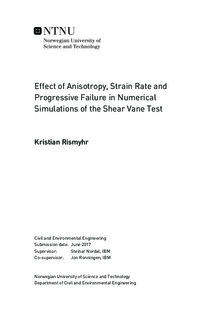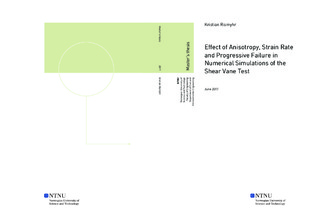| dc.description.abstract | The shear vane test is a method of determining the in-situ undrained strength and remolded shear strength of cohesive soils. During the shear vane test, an increasing torque is applied until the surrounding soil goes to failure. When the torque at failure is known, the shear strength can be determined by means of an idealized and simplified formula which correlates torque and shear strength.
Previous tests have shown that several aspects of cohesive soil material behavior such as anisotropy, strain softening (progressive failure) and strain rate, which are not incorporated in the simplified formula, affect the measured strength from the shear vane test. This implies that the interpretation of the undrained shear strength from the shear vane test is more complicated than the simplified and idealized formula used today.
In this report, numerical simulations have been conducted in Plaxis 2D and Plaxis 3D in order to investigate to which extent progressive failure (softening), anisotropy and strain rate affect the measured strength from the shear vane test. The material models used were Mohr-Coulomb, Geofuture Soft Clay (a user defined material model developed by NTNU) and the total stress based NGI ADP model.
The Mohr-Coulomb material model was applied in Plaxis 2D and 3D to determine the effects of progressive failure. From the Mohr-Coulomb simulations conducted, the effect of progressive failure from the 2D and 3D simulations were 2% and 4% respectively. The simulations conducted seem to suggest that the effect of progressive failure can be neglected when using the Mohr-Coulomb material model.
The Geofuture material model was applied in Plaxis 2D to determine the effects of strain rate during the shear vane test. Several simulations were conducted in which the time to failure varied. Based on the simulations conducted, a tenfold increase in time to failure decreases the measured strength by 7-8%.
The NGI ADP material model was applied in Plaxis 3D to determine to which extent anisotropy affects the strength determined in the shear vane test. The degree of anisotropy was measured by the plasticity index (Ip) of the soil. For each simulation the active shear strength was kept constant while the direct and passive strengths varied as a function of Ip. Based on the simulations conducted, the torque at failure increases by 4% per 10% increase in Ip. | |

